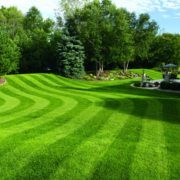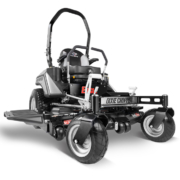1. DO mow often, but DON’T mow too short.
Maintaining a healthy lawn requires mowing your lawn frequently (around once a week) to keep the ends healthy and to stimulate growth. Let it grow naturally and don’t cut it shorter than around half the stem length. Cutting grass too short shocks the plant and prevents it from growing properly.
Keep in mind that this length varies depending on the type of grass you are growing, so you should always consider the species of grass before determining how short to cut.
2. DO fertilize but DON’T necessarily use chemicals.
Fertilizing is important, as it helps feed your grass the nutrients it needs. You can start fertilizing around the time you start mowing your lawn. Try not to fertilize during the hottest days, as this can burn the grass.
Keep in mind that fertilizer doesn’t have to be a store bought, synthetic brew. Organic, all-natural fertilizers work just fine, as well as, mulched grass clippings and shredded leaves. Grass clippings work well to naturally replenish the soil, and are easy to disperse evenly on the lawn during and after mowing. Other organic fertilizers include manure, bone meal, and compost.
3. DO follow a regular watering schedule but DON’T overwater.
Your lawn needs regular watering. If you live in a dry area or if it’s a particularly dry season, make sure you are supplementing rainfall with your watering. Consider installing an irrigation system to ensure your plants are receiving adequate access to moisture. Water in the early morning between 6 and 10 am, as this gives your plants adequate time to absorb the moisture before it evaporates under the hot sun.
Water deeply, but infrequently-aim for a good soaking every two to three days. Conversely, try not to overwater. Watering too often can leave your lawn soggy and cause fungi to grow.
4. DO pay attention to the time of day but DON’T ever cut wet grass.
Try to mow your lawn in the afternoon. Before noon, your grass should still be damp from morning dew or watering. Cutting wet grass inhibits further growth, and also makes the lawn more susceptible to damage and soil compaction. Plus, wet grass will clog your mower blades and make the chore more tedious. Set aside time for regular lawn maintenance, and follow a strict schedule to avoid working your lawn at the wrong times.
5. DO plan ahead but DON’T feel like everything must be done at once.
Regardless if you are a first-time landowner or a seasoned expert, planning out your summer landscape and lawn care is crucial. Don’t attempt to tackle your landscaping plan haphazardly. Dedicate spaces to vegetables, lawn, perennials, and annuals, and then stick to your plan.
At the same time, you shouldn’t feel like you need to transform your front yard into a verdant oasis in just one season. Landscaping is not cheap, and while curb appeal and home value both increase as you improve the landscape, it can be cost-prohibitive to do it all at once. Add a new garden bed, seed a section of lawn, or plant new shrubs one at a time, and don’t let yourself become overwhelmed by the vast array of opportunities available to you. Taking care of your lawn shouldn’t be overwhelming, so take it easy and improve your lawn slowly, year by year.




